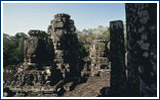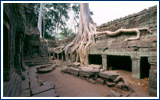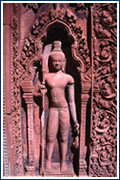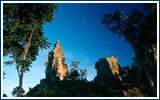| |
|
| Angkor |
| A visit
to the temples of Angkor is a profound experience,
as few sights on earth can match the majesty of
Angkor Wat or the mysterious faces of the Bayon.
The world-famous temples of Angkor are situated
in the northwest province of Siem Reap. There are
more than 1000 temples, built between the 9th and
13th centuries, and these remaining structures are
the sacred skeleton of what was once the social,
religious and administrative centre of the Khmer
Empire. |
| |
| The constant
building projects undertaken by successive Khmer
kings is on a similar scale to the construction
of the pyramids by the ancient Pharaohs of Egypt.
The Khmer rulers made use of a vast force of slave
labour. Each new temple was made possible by the
750,000 people estimated to have lived at Angkor
during the 12th and 13th centuries. |
| |
| Despite
the scores of temples that remain today, there is
little evidence of the inhabitants of what was one
of the biggest cities on earth in its time. This
is because the people - from slaves to the King
himself - lived in wooden structures, all of which
have long-since vanished. Buildings of stone were
reserved for the Gods. |
| |
|
| |
| Portuguese
travellers are believed to have been the first Europeans
to gaze in wonder at the temples of Angkor while
exploring the region during the 16th Century. However,
most of the credit for the "discovery"
of Angkor has fallen to French botanist Henri Mouhot,
whose visit to Angkor in 1860 was posthumously documented
in Paris in 1868. During the remainder of the 19th
Century and into the 20th Century, several French
expeditions visited the temples and work was carried
out to clear the jungle, which had enveloped most
of the monuments. |
| |
In
1907, Thailand returned control of Angkor to Cambodia
and in the same year the first tourists arrived.
In the early days of tourism, visitors to Angkor
followed one of two circuits to see the temples,
the Little (Petit) Circuit or the Big (Grand)
Circuit. Tours were often undertaken on the back
of an elephant. Today things are different, and
air-conditioned vehicles make the experience faster
and more comfortable. Hanuman Tourism-Voyages
can arrange anything from day trips around the
principal monuments to one week itineraries that
include lost temples in the jungle. See our Angkor
Tours for more details. |
| |
Angkor
Wat
There are few
places on earth to match the splendour of Angkor
Wat. The temple is the largest religious buildings
ever constructed and is truly one of the wonders
of the world.
|
| |
Believed to
have been undertaken as a temple and mausoleum
for King Suryavarman II at the peak of the Khmer
empire in the first half of the 12th century,
Angkor Wat is the best-preserved of the Angkorian
temples. As with other Angkorian temples
and walled cities such as Angkor Thom, the central
theme of Khmer architecture revolved around
the idea of the temple-mountain. By the time
building on Angkor Wat was begun early in the
12th century, this had been elaborated to a
central tower surrounded by four smaller towers.
The central monument represents the mythical
Mount Meru, the holy mountain at the centre
of the universe, which was home to the Hindu
god Vishnu.
The five towers symbolise Mount Meru's five
peaks. It is difficult to express in words the
enormous size of Angkor Wat, but it can be hinted
at in part by a look at the scale of the complex.
The temple is surrounded by a moat which makes
the one around the Tower of London, built at
roughly the same time, look like nothing more
than a garden pond. At 190m wide and forming
a rectangle 1.5km by 1.3km, it is hard to imaginzs
around the walls of the outer gallery and the
hundred figures of devadas and apsaras. This
intricately carved gallery tells stories of
the Hindu gods and of Suryavarman II's successes
on the battlefield. A visit to Angkor Wat is
the experience of a lifetime and will be cherished
forever.
|
| |
Phnom
Bakheng
Dominating the
flat landscape, this 10th Century mountain temple
is the most popular spot in the area to watch
a classic sunset over Angkor Wat and the surrounding
forest. |
| |
Angkor
Thom
This huge walled complex was the centre of the
world’s largest city in 1200. The royal
city was first built under the reign of Udayadityavarman
II in the 11th Century. It was destroyed when
the Chams from Vietnam invaded, sacking the city,
and was subsequently rebuilt by King Jayavarman
VII at the end of the 12th Century.Its vast walls,
some 6m wide, 8m high and 13km in length contain
many monuments. |
| |
 |
The
Bayon
Surrounded by faces on all sides, visitors
never forget the Bayon. This symbolic temple
mountain, built by Jayavarman VII, is situated
in the centre of the city of Angkor Thom.
It is a three-tiered pyramid with its entrance
facing east. |
|
| |
| The
central shrine is surrounded by 54 towers, all
crowned by gigantic, enigmatic faces, representing
Lokiteshvara, but withthe features of Jayavarman
VII. They gaze out to the north, south, east and
west. Unlike his predecessors who had worshipped
the Hindu deities of Shiva and Vishnu, Jayavarman
VII adopted Mahayana Buddhism as the fount of
royal divinity. This sets the Bayon apart from
many other Angkorian monuments. |
| |
The
Baphuon
This perfect pyramidal temple, built by Udayadityarvarman
II, was the most poorly constructed of all the
temples in Angkor. From the remaining ruins, it
is possible to see how imposing it was. This temple
mount was dedicated to Shiva, but in its reliefs
many motives from Vishnu’s life can be seen.
Complexed work continues at the Baphuon to preserve
it as a partial ruin complete with a huge reclining
Buddha, added in the 16th Century. |
| |
Terrace
of Elephant
Terrace of the Elephants and Terrace of
the Leper KingAt the North of the Baphuon
lies the original royal city, of which very
little remains.
|
|
|
The
first terrace owes its name to the outstanding
depiction of elephants, and was used as a viewing
gallery at royal events, while the second terrace
takes its name from the magnificent sculpture
of King Yasovarman, popularly known as the Leper
King. The original of this statue is now in the
National Museum. |
| |
 |
Ta
Prohm
This temple is perhaps the most atmospheric
of all Angkor’s treasures. The temple
was a monastery built by Jayavarman VII
as a residence for his mother. Ta Prohm
has been left to the destructive power of
nature by archaeologists to demonstrate
the awesome power of nature. |
|
| |
It
has been largely consumed by the jungle and as
you climb through the dilapidated stone structures
you see many giant trees growing out of the top
of the temple itself. At every turn you expect
to see Indiana Jones or Lara Croft step out from
behind a fallen pillar. It is one of the most
regularly visited temples, with visitors often
arriving during the middle of the day to take
advantage of the protective forest canopy above
the ruined temple. Ta Prohm looks as many of the
monuments did when European explorers first laid
eyes on them. |
| |
Preah
Khan
Built in the same style as Ta Prohm, Preah Khan
is a much better state of preservation. Meaning
The Sacred Sword, this temple was also built by
Jayavarman VII and is famous for its immensely
long cruciform corridors and delicate carvings. |
| |
Ta
Keo
King Suryavarman I commissioned this temple in
the 10th Century, but it was never completed so
has no elaborate decoration like its contemporaries.
It is a pyramid on 5 levels and is dedicated to
Shiva. |
| |
Banteay
Kdei
This temple was constructed by Jayavarman VII
during the 12th and 13th Centuries. Its system
of galleries and vestibules that were added after
the construction of the main towers makes it look
like a cloister. It was built in sandstone, which
has deteriorated quite badly. However, there remain
some very beautiful lintels and pediments. |
| |
Sras
Srang
This royal pool was the King's bathing pond, where
he washed with his many concubines each day. |
| |
| Pre
Rup
This temple was built in the 10th Century by Rajendravarman.Pre
Rup means turning the body and the Khmers believe
this temple was used for cremations. |
| |
East
Mebon
Also built in the 10th Century by Rajendravarman,
this temple was situated on a small island in
the middle of the Oriental, or Eastern, Baray. |
| |
Neak
Poan
This temple is a delicate highlight of Khmer art.
Built by Jayavarman VII, this temple is the perfect
representation of the heavens on earth. It has
been said that this monument was consecrated to
Buddha who attained Nirvana, and the ornamental
lakes surrounding it were meant as places where
pilgrims could wash and purify themselves before
reaching perfection. In the centre of these ornamental
lakes there is a small temple surrounded by two
nagas. |
| |
Banteay
Samre
Thoroughly restored before the war, this delicate
temple demonstrates how Angkor may have looked
in its prime. It was built by Suryavarman II. |
| |
Phnom
Krom
Built by Yasovarman I in the 10th Century, this
temple sits atop a hill overlooking the Tonle
Sap Lake. The temple is in very poor condition,
but its ruins are worth visiting for views. This
is the place for a quiet sunset. |
| |
Barays
The East and West Barays are two enormous reservoirs,
both dug by hand. They were central to the health
and vigour of Khmer civilisation. The East Baray
is empty, while the Western one is half full,
measuring 8km in length! |
| |
Roluos
Roluos was one of the earliest Angkor capitals,
built by King Indravarman and originally called
Hariharalaya. Today there are three Hindu sanctuaries:
Preah Ko, Bakong and Lolei.
All three temples were built of brick and though
they are not as spectacular as the other temples
of Angkor, they are well preserved and worth a
visit to offer the visitor a chronological perspective
on the development of Angkor. Roluos is 11km east
of Siem Reap on National Highway 6 to Phnom Penh. |
| |
 |
Banteay
Srei
This jewel of Angkor was built by a Brahman
in the 10th Century and dedicated to Shiva.
The famous pink sandstone structure bears
a series of exquisite sculptures, lintels
and friezes. These, it is said, must have
been carved by women as the detail is too
fine for the hands of a man. This gives
the origin of the Khmer name, Fortress of
the Women. While it may be a small temple
complex, the beauty of Banteay Srei is found
not in the scale, but the detail. Many believe
the intricate carving is the best example
of Khmer classical art in existence. |
|
| |
Kbal
Spean
Better known as the River of a Thousand
Lingas, this is an area of riverbed carvings
and lush jungle. There are several carvings
of Hindu deities in the sandstone here,
as well as thousands of lingas in the riverbed
itself. This site was only ‘rediscovered’
in 1969 and is a tranquil place with an
attractive waterfall. It is 50km north of
Siem Reap. |
|
|
|
Phnom
Kulen
Phnom Kulen is considered by Khmer people to be
the most sacred mountain in Cambodia and is a
popular place of pilgrimage. It played a significant
role in the history of the Khmer empire as it
was from here in 802 AD that Jayarvarman II proclaimed
independence from Java, giving birth to modern
Cambodia. On the plateau, there is a large reclining
Buddha carved into a sandstone boulder and beautiful
views across the jungle. Nearby is a major waterfall
and some riverbed carvings of the sort seen at
Kbal Spean. For more adventurous visitors, there
are many old temples scattered across the mountain,
but these are tough to reach. Phnom Kulen is about
55km north-east of Siem Reap. |
|
| |
Boeung
Mealea
This vast 12th Century temple was constructed
by Suryavarman II in a similar design to his more
famous creation, Angkor Wat. The temple has been
completely swallowed by the jungle and is incredibly
atmospheric. Beng Mealea is 70km north-east of
Siem Reap on reasonable dirt roads. |
| |
Preah
Vihear
This imposing mountain-top temple guards the border
between Cambodia and Thailand. It sits 600m, above
the Cambodian plains below, and many consider
its location the most dramatic of all the Angkorian
temples. Until recently, it was only really accessible
by helicopter from the Cambodian side or from
Thailand by road. However, it was closed to visitors
from the Thai side in December 2001 and new roads
are being constructed to plug it into the rest
of Cambodia. One road is will link it to Tbeng
Meanchey to the south and a second road will link
it to Anlong Veng to the west offering a new loop
between Phnom Penh and Siem Reap. |
| |
Koh
Ker
This served as a capital for a short period in
the 10th Century under Jayavarman IV, who seized
the throne and transferred power here. Also know
as Chok Gargyar, it has several huge temples in
a pinkish sandstone as seen at Banteay Srei, inlcuding
Prasat Thom and Prasat Krahom. It is very tough
to reach and involves an overnight adventure from
Siem Reap or a helicopter flight. |
| |
Preah
Khan
This was once the second city of the Angkorian
empire, and home to Jayavarman VII during his
younger years. It is a vast complex including
a small temple in the style of the Bayon, as well
as small but beautiful Prasat Damrei (Elephant
Temple). It is difficult to get to and involves
an overnight adventure from Siem Reap or Phnom
Penh, or a helicopter flight. |
| |
 |
Banteay
Chhmar
This temple is being developed to receive
visitors and is a big complex meaning Narrow
Fortress. It was badly looted in 1998, but
efforts are now underway to preserve what
remains. It is 160km northwest of Siem Reap
and can now be done as a long day trip or
two-day excursion. |
|
| |
|